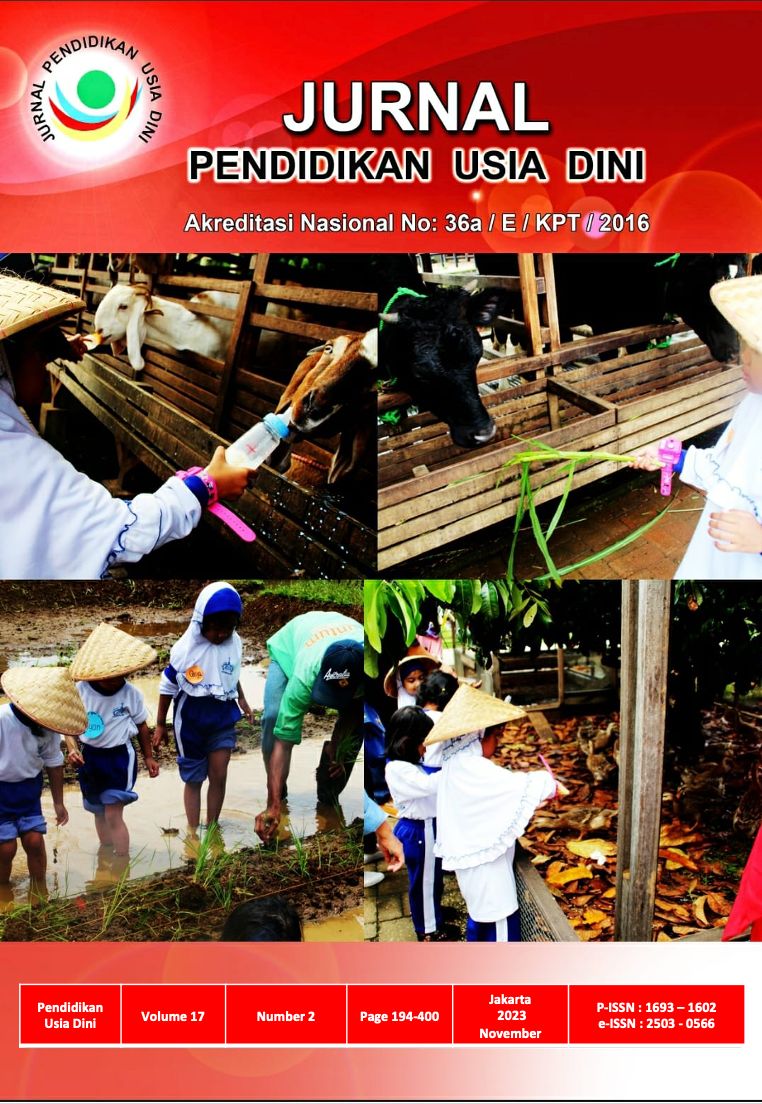Increasing Children's Character Overt Behaviours by Neuro Pedagogy-Based Play
DOI:
https://doi.org/10.21009/JPUD.172.12Abstract
The research aims to improve the character of children aged 4-6 years by implementing the way the individual interacts with the environment. Qualitative research methods were used in this study, where researchers investigated the open behavior of children aged 4-6 years during neuropedagogy-based play, as well as the open behavior of preschool teachers' professional characters in managing play. The participants in this research were 20 children aged 4-6 years and 4 teachers who were chosen deliberately. The results of the study revealed that all the children's overt character behaviors improved after participating in neuropedagogy-based play. There was not a single child who was classified as having open early behavior. On the other hand, preschool teachers consistently demonstrate the implications of their professional behavior. Based on research findings, it is proven that neuro-pedagogy-based play is beneficial for preschool children and teachers. Extrapolated from this interpretation, curriculum designers and teaching practices are informed that neuro pedagogy-based play can strengthen children's character, this is necessary in preparing future generations who can overcome all challenges in the future.
Keywords: neuro pedagogy-based play, open character behavior, children aged 4-6 years
References:
Bandura A (1997) Social Learning Theory. New Jersey: Prentice Hall, Inc A Paramount Communication Company Englewood Cliff
Beibert M. Hanna & Hasellhorn Marcus (2016). Individual Differences in Moral Development : Does Intelligence Really Affect Children’s Moral Emotion? Department of Education and Human Development. German Institute for International Educational Research, Frankfurt am Main. Germany
Bonomo Virginia (2017) Brain-Based Learning Theory. Journal of Education and Human Development, Vol 6 No 1(Online) DOI: 10.15640/jehd.v6n1a3. URL: http://doi.org/10.15640/jehd.v6na3
Bransford J, Brown A, and Cocking, (2000). How People Learn: Brain, Mind and Experience & School. Washington, DC: National Academy Press
Budiartati Emmy. Y & Jamaris Martini (2018) Music Instructional to Develop Character Value for Early Childhood at Fishery Community Tambak Lorok Semarang City. Journal of Non-Formal Education 4, 47-56
Carter R, Aldridge S, Pge M, & Parker S ( 2009 ) The Human Brain Book. New York, NY: DK Publishing
Chojak. M (2018) Neuropedagogy as a Scientific Discipline: Interdisciplinary Description of the Theoretical Basis for the Development of a Research Field. World Academy of Science, Engineering and Technology. International Journal of Education and Pedagogical Science . Vol 12, No 8, 2018
Chudler E.C (2005) Brain Plasticity What is it?. http://www.faculty.washington.edu/chudler/plast.html
Collin Gallian & Dixson Hazel. (1993). Integrated Learning Planned Curriculum Unit (Bookshelf tt)
Collin. JW (2007) The Neuroscience and Learning. The Journal of Neuroscience Nursing: Journal of The American Association of Neuroscience Nurses, 39 (5) pp 395-400
Dick Walter & Carey Lou (1985). The Systematic Design of Instruction. Glenview, Illinois, London England: Scoot, Foresman and Company
Fogerty Robin (1991). How to Integrate Curricula. Palaline: IRI/Skylight Training and Publishing Inc. p xii
Friedman Issac, Grobgeld Etty & Teichman Weinberg Ariela ( 2016). Neuropedagpgy in Teacher Education. The Mofet Institute: International Portal of Teacher Education.
Haghigh Maryam (2013). The Effect of Brain Learning on Iranian EFL Learners ‘Achievement and Retain. Procedia-Social and Behavioral Science, vol 70, page 508-516
Hayes, B. Grant & Hagedorn, W. Bryce (2000).” A Case of Character Education.” Journal of Humanistic Counseling, Education and Development 39, (1) 2-4
Henniger L. Mitchel (2013) Teaching Young Children. One Lake Street, Upper Saddle River, USA: Pearson Education
Intan Ahmad (2019) Pidato Rektor Wisuda Tahun Akademik 2018-2019. Jakarta: Unversitas Negeri Jakarta, 1-12
Keles Esra & Cepni Salih,(2006 ) Brain and Learning. Journal of Turkish Science Education, Volume 3, Issue 2, December 2006
Lapina SJ & Colombo JA. (2009 ) Proverty and Brain Development During Cilhdhood: An Approach from Cognitive Psychology and Neuroccience. Washsington, DC. Amarivan Psychological Association
Likona, Thomas ( 1996) Eleven Principles for Effective Character Education. Journal of Moral Education 25 (1) :93-100
Martini Jamaris (2016) Empowering Logical Mathemetical of the 4-6 Years Old Children through the Neurosensory Instructional Approach. American Journal of Educational Research. Vol 4. No 10, 768-776. DOI: 10.12691/education4-10-10
Martini Jamaris & Sofia Hartati (2017) The Role of Undergraduate Students ‘Self-Regulation and Its Influence on their Academic Achievements. International Journal of Multidisciplinary and Current Research 5 May/June 2017, 544-552
Martini Jamaris, Edwita & Trisna Mulyeni (2019) Instructional Model Based Neuro Pedagogy for Character Education of the 4-6 Years Old Children. Research Report. Jakarta LPPM Universitas Negeri Jakarta.
Nass L. Martin (2017) The Superego and Moral Development in the Theories of Freud and Piaget. The Psychoanalytic Study of the Child, Volume 21, 1966,Issue1 1. Contribution of Psychoanalysis Theory. http://doi.org/10.1080/00797308. 1966. 11823252
O’Rahilly R, Mueller F ( 2008) Significant Feature in The Early Prenatal Development of The Human Brain. Annal Of Anatomy
Porter Nancy (1972) Kohlberg and Moral Development. Journal of Moral Education volume 1 1972, Issue2. Publish on line 7 Juli 2016, http://doi.org/10.1080/0305724720010206
Rushton. Stephen, Rushon - Jualo Anne & larkin Elizabeth (2019) Neuroscience, Play and Early Childhood Education: Connections, Implications and Assessment. Early Childhood Education Journal 37: 351-361. DOI 10.1007/s10643-009-0359-3
Santrock, W. John (1996 ) Child Development. Chicago: Brown & Benchmark
Seravac, Zoran & Jevanovic Jelena ( 2012) Adaptive Neuro-Fizzy Pedagogical Recommender. Expert Systems with Applications. Volume 39, Issue 10. , 9797-9806
Shearer, Banton (2018). Multiple Intelligences in Teaching and Education Lessons Learned from Neuroscience. Journal of Intelligence, Vol 6, No 38; doi: 10.3390/jintellgence6030038
Soldz ,Stephen (1988) The Construction of Meaning: Kagan, Piaget, and Psychoanalysis. Journal of Contemporary Psychotherapy 18 (1) p 46-59 the phenomena of mind.Nature.com/scitable/blog/brain )
Voytek, Brown (2013) Brain Matricts: How measuring brian biology can explain.
White E. Rachel (2012) Power of Play. Minnesota: Minnesota Children’s Museum
Downloads
Published
How to Cite
Issue
Section
License
JURNAL PENDIDIKAN USIA DINI work is licensed under a Creative Commons Attribution 4.0 International License. (http://creativecommons.org/licenses/by/4.0/)





